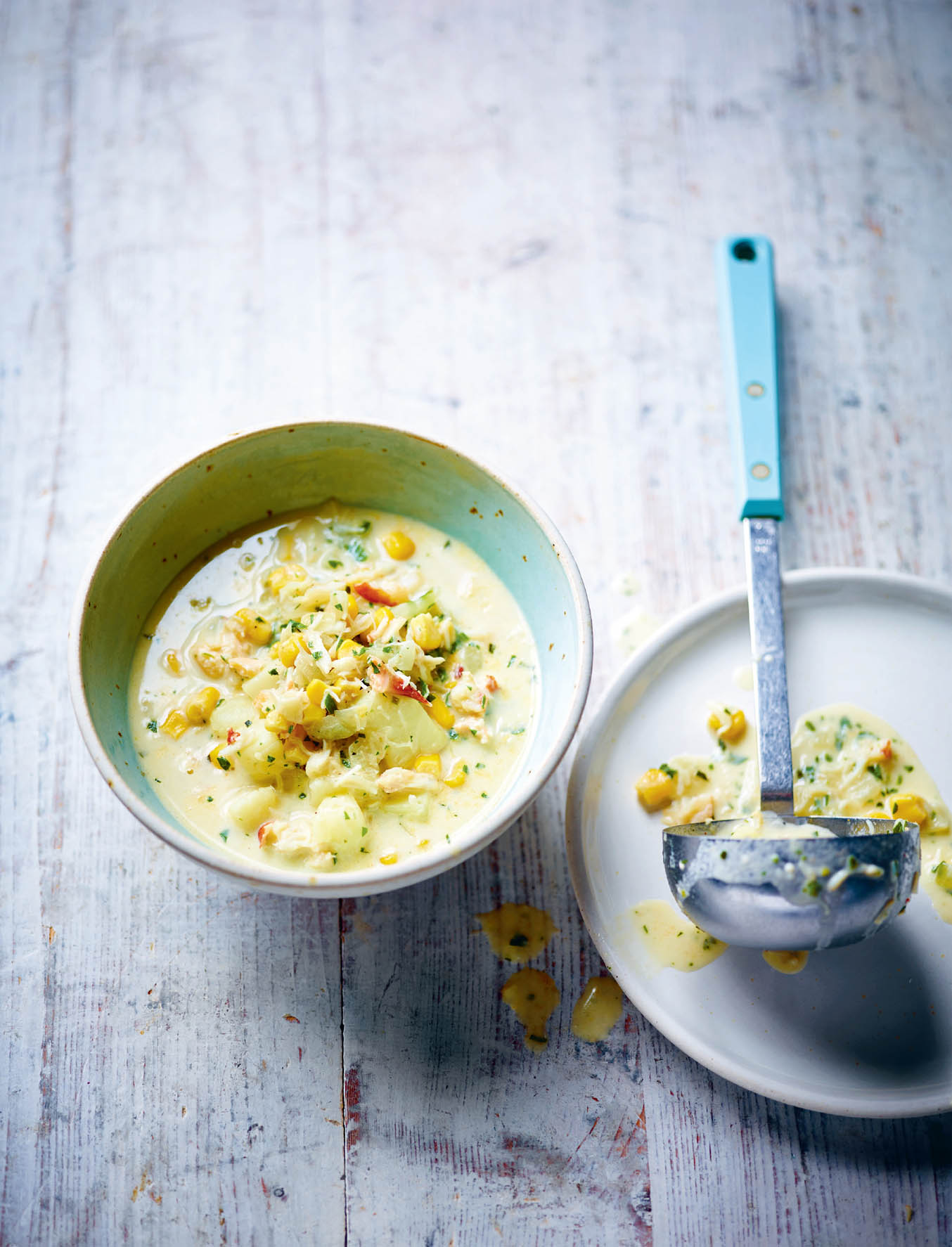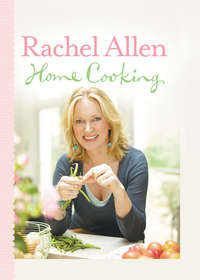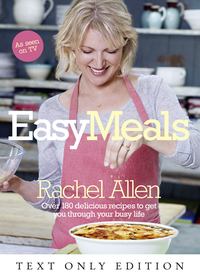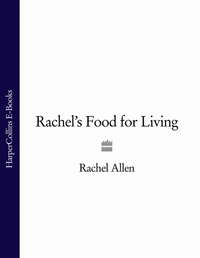
Полная версия
Recipes from My Mother
TIP
You can either make all the crêpes first then fill and bake them one at a time, or if you have two pans and a bit of nerve, you can leave one pan cooking the finished crêpe in the oven while the other is cooking the batter on the hob.
Potato pancakes with black pudding and glazed apples
MAKES 12 PANCAKES
A great way to use up leftover potatoes, these little pancakes are almost blini-like and I adore the meaty black pudding and sweet, sticky glazed apple topping. Another great topping for these pancakes is the Beetroot, Dill and Horseradish Gravlax with Mustard and Dill Mayonnaise.
For the pancakes
75g (3oz) plain flour
½ tsp baking powder
½ tsp sea salt
2 eggs
125ml (4½fl oz) milk
225g (8oz) cold mashed potato (no butter or milk added)
15g (½oz) butter, for frying
For the glazed apples
40g (1½oz) butter
2 eating apples, peeled, quartered, cored and cut into 5mm (¼in) slices
30g (1¼oz) caster sugar
juice of ½ lemon
For the sage butter
50g (2oz) butter
2 tsp chopped sage
For the black pudding
15g (½oz) butter
about 24 slices (cut 7.5mm/⅜in thick) black pudding (2 per pancake) – peel the skin off the black pudding before slicing
1. First, make the pancakes. Sift the flour and baking powder into a bowl, add the salt and mix. Crack the eggs into another bowl and whisk, then mix in the milk and mashed potato. Pour this into the dry ingredients, whisking as you add it. Set aside.
2. Heat a pan over a medium heat. Rub a piece of kitchen paper in the butter and wipe it over the base of the pan – do this each time you put in a new batch of batter. When the pan is hot, drop generous tablespoonfuls of the batter, spaced apart, in the pan. Cook for 2 minutes until golden underneath, then turn over and cook the other side until golden. Remove from the pan and keep them warm while you make the others.
3. Meanwhile, place a pan (another frying pan if you have one) over a medium-high heat and add the butter for the glazed apples. Allow it to melt and foam, then tip in the apple slices and spread them out. Toss them over the heat for a few minutes until they are light golden, then add the sugar and lemon juice and continue to toss until the apples are tender and beautifully glazed. Keep warm.
4. In a small saucepan, melt the butter for the sage butter and add the sage. Allow it to foam, then take the pan off the heat.
5. To cook the black pudding slices, place a frying pan over a medium-high heat and add the butter. Add the black pudding slices and fry until they are cooked on both sides and hot inside.
6. Divide the warm pancakes among warm plates. Top each pancake with a few glazed apple slices, then 2 slices of black pudding and, finally, a drizzle of hot sage butter.
Cheese and bacon muffins
MAKES 12 MUFFINS
These great savoury muffins are just crying out to be packed up and taken on a picnic. I often use a mixture of leftover delicious farmhouse cheeses in these, which ensures they’re slightly different every time I make them.
150g (5oz) streaky bacon rashers
225g (8oz) plain flour
2 tsp baking powder
1 tbsp caster sugar
1 tsp sea salt
pinch of freshly ground black pepper
125g (4½oz) cheese, grated (I like a mixture of Cheddar, Gruyère and Parmesan)
1 egg
75g (3oz) butter, melted
225ml (8fl oz) milk
1 tsp Dijon mustard
1. Preheat the oven to 190°C (375°F), Gas mark 5. Line a 12-cup muffin tray with 12 paper cases.
2. Cook the bacon rashers in a frying pan over a medium heat until golden and crisp on both sides. Chop into pieces 1cm (½in) in size.
3. Sift the flour and the baking powder into a bowl. Add the sugar, salt and pepper, then mix in the grated cheese and crisp bacon pieces. Whisk the egg in another bowl and mix in the melted butter, the milk and the mustard. Make a well in the centre of the dry ingredients and stir in the wet ingredients until combined.
4. Divide the mixture among the 12 paper cases and bake in the oven for 20–25 minutes until golden and a skewer comes out clean from the centre of a muffin. Transfer to a wire rack to cool.
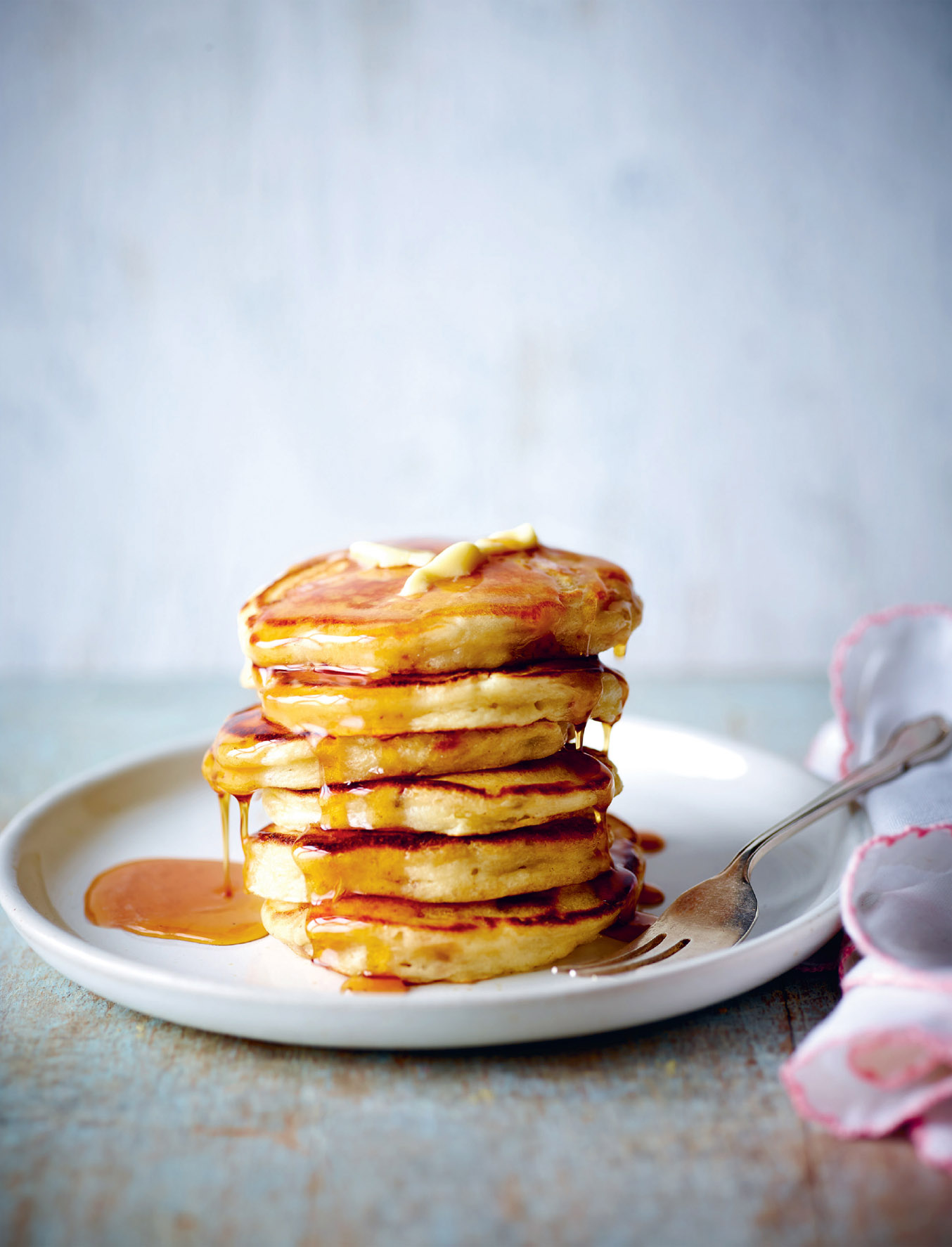
Banana pancakes
MAKES ABOUT 12 PANCAKES
Our boys loved these when they were little, and they still love them now. The bananas are great for adding natural sweetness and, of course, nutrition-packed goodness, too.
150g (5oz) plain flour
1 tsp baking powder
¼ tsp bread soda (bicarbonate of soda)
1 tbsp caster sugar (optional)
2 eggs
150ml (5fl oz) buttermilk
25g (1oz) butter, melted
1 large or 1½ medium bananas, peeled and mashed just before using
a few knobs of butter
butter or maple syrup, to serve
1. Sift the flour, baking powder and bread soda into a bowl. Add the caster sugar (if using) and stir to mix.
2. Crack the eggs into another bowl and whisk, then stir in the buttermilk and melted butter. Make a well in the centre of the dry ingredients and pour the liquid into the dry ingredients, whisking as you add it. The batter is ready to use or can be stored in the fridge overnight.
3. Just before you want to cook the pancakes, fold the mashed bananas into the batter.
4. Heat a large frying pan over a medium heat and melt a couple of knobs of butter, making sure the base of the pan is covered with a thin layer of butter. I normally wipe the butter all over the pan with some kitchen paper, which I’ll use to re-butter the pan for each batch of pancakes.
5. Drop large spoonfuls (about 50ml/2fl oz each) of the pancake batter into the hot pan – leave plenty of space between them as the pancakes spread while cooking. Turn the heat down slightly or the pancakes will burn before they’re cooked in the centre. You should be able to fit four or five in the pan at a time. Cook on the first side until bubbles appear and pop on the upper surface – 1–2 minutes – then, using a fish slice or something similar, turn the pancakes over and finish cooking on the other side for another minute or so until golden brown. Cook all the pancakes in this way in a few batches, keeping the cooked ones warm in a low oven until they are all ready. Serve with butter or maple syrup – or both.

Kedgeree
SERVES 6–8
My friend Helen, who grew up in England with an Irish father and a mother from New Zealand, says that the taste of kedgeree will always bring her back, in an instant, to when she was little, sitting round the table with her family having brunch. It’s a great recipe for feeding a crowd and, of course, it’s good at any time of the day. This curried rice dish, made with delicious fresh or smoked fish, hard-boiled eggs and lots of intensely green parsley, is inspired by Helen’s mum’s recipe. Thanks, Beth!
450g (1lb) white or brown basmati rice
15g (½oz) butter
500g (1lb 2oz) smoked haddock (you could smoke your own as on here), skinned, deboned and cut into 2.5–5cm (1–2in) chunks
4 tbsp extra-virgin olive oil
2 large onions, thinly sliced
2 tsp ground cumin
2 tsp ground coriander
¼ tsp ground turmeric
pinch of cayenne pepper
½ tsp garam masala
8 eggs
225g (8oz) fresh or frozen peas
75ml (3fl oz) regular or double cream
2 tbsp chopped parsley
sea salt and freshly ground black pepper
1. Bring a large pan of water to the boil, add the rice with a good pinch of salt and cook over a medium heat, stirring from time to time, until tender – be careful not to overcook it or it will go mushy. White basmati rice will take only 10–12 minutes, while brown basmati rice will take 25–30 minutes to cook.
2. Place the butter in a frying pan over a medium-high heat and allow to melt and foam. Add the smoked fish pieces and 1 tablespoon water. Season with black pepper, turn the heat down slightly and cook, tossing regularly, until the fish is just opaque, 4–5 minutes.
3. Meanwhile, place a large frying pan over a high heat and heat the olive oil until hot, then add the sliced onions and sauté for 5 minutes, tossing regularly, until almost softened and golden at the edges. Add the ground cumin and coriander, the turmeric, cayenne pepper and garam masala. Turn the heat down to low, cover the pan with a lid and continue to cook the onions until they are completely softened, 5–8 minutes.
4. While the onions are cooking, bring a pot of water up to the boil, gently drop in the eggs and boil for just 6 or 7 minutes, depending on the size. When they are cooked, drain and pour cold water over them to stop them cooking. Once they are almost cool, peel the eggs, handling them gently as they’ll be slightly soft in the centre.
5. Drop the peas into a pan of boiling water and boil for just 2 minutes or until cooked.
6. Once everything is cooked, you can assemble the dish. Add the drained rice and peas to the onions in the frying pan over a low heat and stir to mix. Carefully stir in the fish with any lovely juices. Pour in the cream and half the chopped parsley and mix gently, then season with salt and pepper to taste.
7. Transfer to a wide, shallow serving bowl. Cut the eggs into quarters and arrange on top and around the sides, then sprinkle with the remaining chopped parsley and serve.
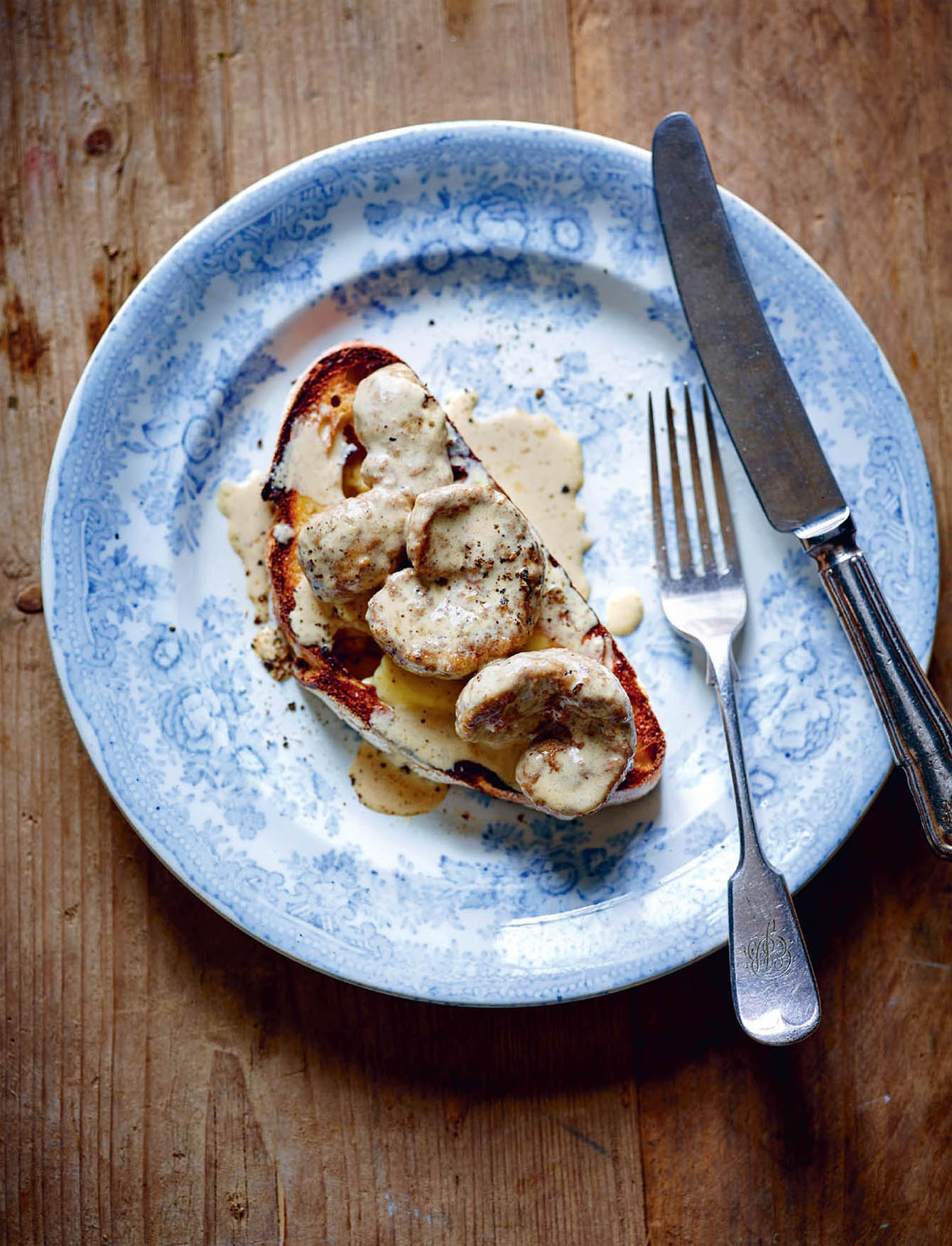
Devilled kidneys
SERVES 4–6
A classic Victorian British breakfast dish, this would set you up for the day – and then some! Of course, it’s great at any other time of the day, too, if kidneys are too hardcore for your morning ritual.
2 tbsp plain flour
¼ tsp cayenne pepper
¼ tsp grated nutmeg
1 tbsp sherry vinegar
1 tbsp Worcestershire sauce
1½ tsp Dijon mustard
90ml (3½fl oz) chicken stock
175ml (6fl oz) regular or double cream
25g (1oz) butter
6 lamb’s kidneys, peeled, halved, all membranes removed, fat snipped from core, cut into 6 pieces (3 from each half)
sea salt and freshly ground black pepper
To serve
hot buttered toast or buttery mash
1. Mix the flour, cayenne pepper, nutmeg and a generous pinch of salt and pepper in a bowl and set aside.
2. In another bowl, combine the vinegar, Worcestershire sauce, Dijon mustard, chicken stock and cream, then set aside.
3. Heat the butter in a pan over a high heat. Toss the kidneys in the flour mix and, when the butter is foaming, cook the kidneys, turning them so that they brown on all sides. Next, pour in the cream mixture and allow it to bubble and thicken.
4. Serve on hot buttered toast or with buttery mashed potatoes.
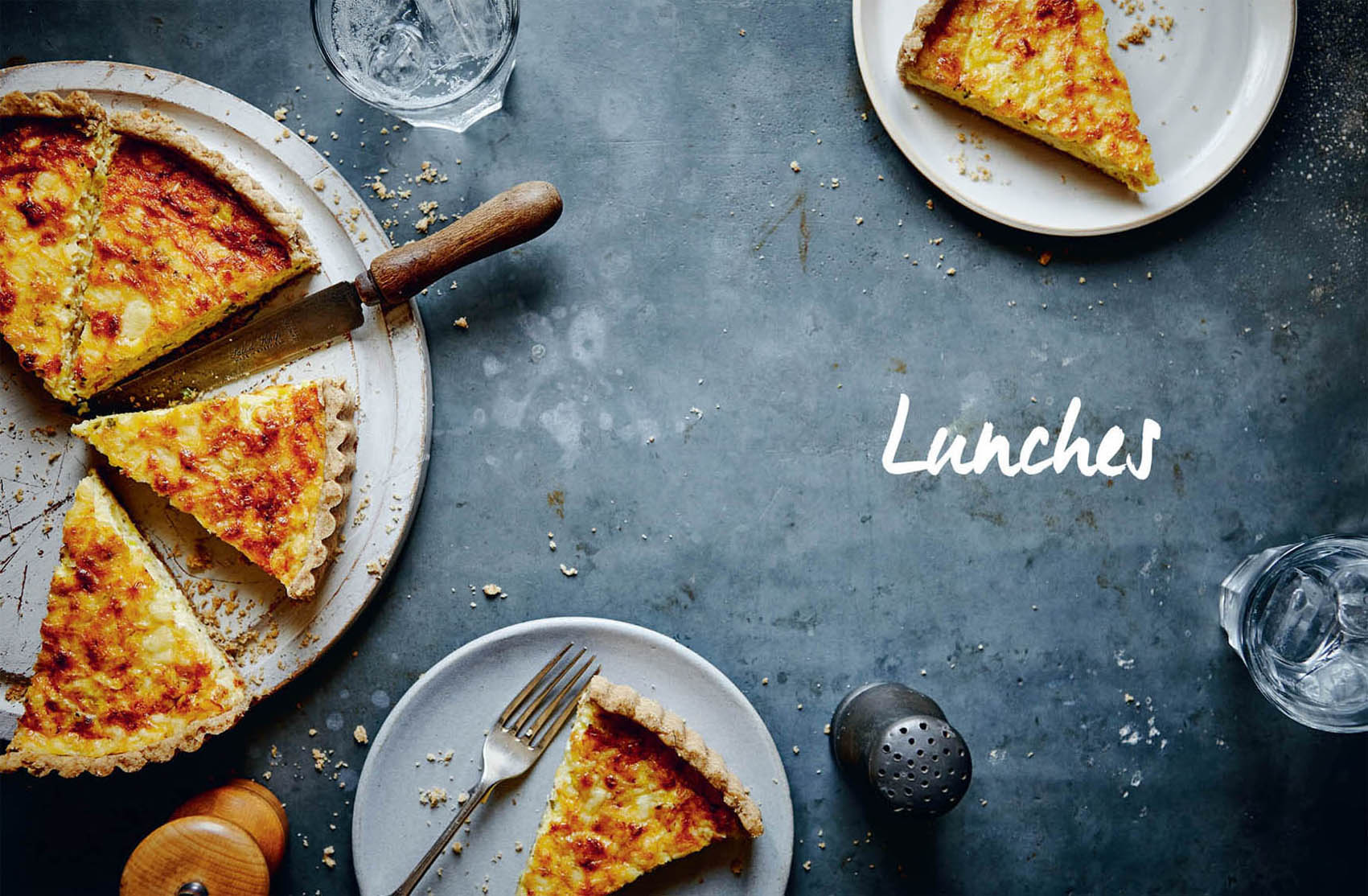

Chicken stock
MAKES 1.5–2 LITRES (2½–3½ PINTS) STOCK
I always have a pot of chicken stock on the go. When you’re using good chickens for roasting or braising, it’s crazy not to boil up the bones afterwards. There’s an old South American proverb that says, ‘Good broth will resurrect the dead,’ and it’s not far wrong as the nutritional content of a homemade stock indeed has miraculous qualities if eaten regularly. Our great-grandmothers were right after all.
1 whole chicken carcass, raw or cooked
1 large leek, cut into 4 pieces
2 celery sticks, each cut into 4 pieces
2 carrots, each cut into 4 pieces
2–4 garlic cloves, to taste, peeled
1 bouquet garni (a few sprigs of parsley, 1 or 2 sprigs of thyme and a small bay leaf)
a few black peppercorns
pinch of sea salt
1. Preheat the oven to 200°C (400°F), Gas mark 6. Place the chicken bones in a roasting tin and cook in the oven for 15 minutes. The roasting stage is optional but I love the slightly stronger, more enhanced flavour that it gives the final broth.
2. Once the bones are roasted (see tips), transfer them to a large saucepan and add the leek, celery, carrots and garlic cloves. Pop in the bouquet garni and black peppercorns, then cover generously with cold water – adding about 2 litres (3½pints). The water must be cold since, while it’s slowly heating up, it will draw the flavour and goodness out of the vegetables and the bones.
3. Bring to the boil, then turn the heat down and simmer for 2 hours, skimming off and discarding any foam that rises to the surface.
4. Once it’s cooked, strain the broth through a fine sieve, then leave to stand to allow the fat to rise to the top. Skim off the fat and season the broth with salt to taste.
TIPS
If there are any bits of meat or little caramelised nuggets of flavour stuck to the roasting tin after cooking the chicken bones, place the tray over a medium heat on the hob, pour in a small glass of water and, using a whisk, scrape to dissolve the bits. Pour these into the saucepan too.
I’ve found that if I leave the fat sitting on top of the stock while it’s in the fridge there are two added bonuses – once the fat is chilled it’s far easier to lift it off the stock; and the stock keeps for longer (a few weeks rather than just a few days) in the fridge if completely covered in the fat. Remove the fat before use.
Chicken noodle broth
SERVES 6–8
I remember many versions of this broth while growing up – I don’t think it was ever the same twice. Mum seemed to constantly have a delicious chicken stock on the go, which always went into this most restorative of soups – a hug in a bowl.
1.6 litres (2¾ pints) chicken stock, well strained
4 garlic cloves, finely sliced
160g (5½oz) spaghetti, broken into 2.5cm (1in) lengths
4 tbsp chopped parsley
sea salt and freshly ground black pepper
1. Put the chicken stock, garlic and spaghetti into a saucepan and season with a pinch of salt and pepper. Cover and bring to a gentle boil, then turn the heat down and simmer for 8–10 minutes until the spaghetti is cooked (or cook for the length of time specified on the packet).
2. When the spaghetti is cooked, stir in the parsley, check the seasoning and serve.
Chicken broth with chilli and ginger
SERVES 4
1.2 litres (2 pints) cold chicken or vegetable stock, well strained
20 large sprigs of coriander or flat-leaf parsley, stalks and leaves separated
½–1 red chilli, to taste, finely sliced (leave the seeds in if you dare!)
2cm (¾ inch) piece of fresh ginger, finely sliced
sea salt and freshly ground black pepper
1. Put the cold stock in a saucepan and add the coriander or parsley stalks (keep the leaves for serving), sliced chilli, ginger and a little salt and pepper. Bring to the boil, then taste and add more seasoning, if you like.
2. Ladle into warm bowls or cups and serve scattered with the coriander or parsley leaves – whole or chopped, whichever you prefer.

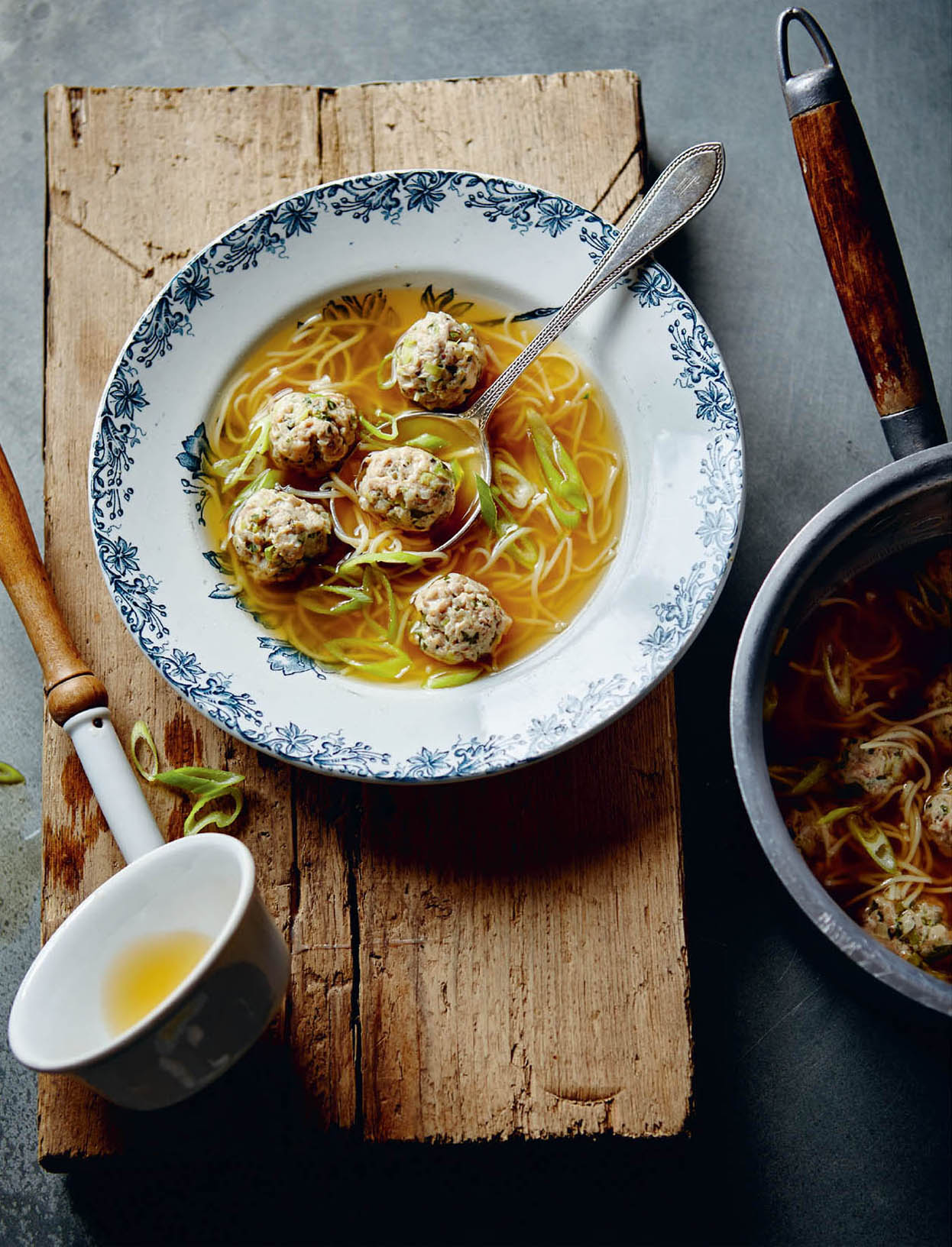
Chicken dumpling soup
SERVES 4
A twist on the age-old Asian dumpling soup, this is deeply satisfying and wonderfully restorative. The better the chicken stock, the better the soup.
300g (11oz) minced chicken (thigh is best but breast works fine too)
1 small garlic clove, crushed
2 tbsp chopped parsley
¼ tsp grated nutmeg
60g (2½oz) spring onions, white parts finely chopped and green parts sliced at an angle, kept separate
a little oil
1.5 litres (2½ pints) chicken stock
handful of broken spaghetti (optional)
sea salt and freshly ground black pepper
1. Place the minced chicken in a bowl and add the garlic, parsley, ¼teaspoon salt, the nutmeg and a twist of black pepper. Add the white parts of the spring onions and mix well to combine. Break off a small piece of the mixture and fry it in a little oil, then taste it and adjust the seasoning if needed.
2. With wet hands, shape the minced chicken into 20 equal-sized dumplings. Set aside in the fridge while you prepare your chicken broth.
3. Pour the stock into a saucepan, add salt and pepper if necessary, and bring it to the boil. Add the chicken dumplings and bring to a gentle simmer for 10 minutes to cook the dumplings through. (If you want to make this soup more substantial, add a handful of broken spaghetti strands and cook with the stock and the dumplings.)
4. Add the green parts of the spring onions for the last minute of cooking. Divide the broth and the dumplings among four bowls and serve.

Chorizo, bean and kale broth
SERVES 6
I have a problem with chorizo, in that I cannot get enough of the stuff. It has an amazing ability to give its characteristic kick to everything – from chicken and shellfish to pulses and grains. This is the kind of chunky soup that I adore; full of flavour and bursting with goodness.
125g (4½oz) dried borlotti beans, haricot or butter beans (or use 250g/9oz tinned beans, drained and rinsed)
1 tbsp extra-virgin olive oil
1 red onion, chopped
1 carrot, chopped
1 celery stick, chopped
1 garlic clove, chopped
110g (4oz) chorizo, skin removed, cut into dice
200g (7oz) tomatoes, chopped
1.2 litres (2 pints) chicken or vegetable stock
75g (3oz) de-stalked kale, roughly chopped
1 tbsp chopped parsley
1 tbsp chopped rosemary
pinch of grated nutmeg
sea salt and freshly ground black pepper
To serve
crusty bread
1. First prepare the beans, if using dried beans. Soak the dried beans in plenty of cold water overnight. The next day, drain and place in a pan of fresh cold water and boil for 45–60 minutes until tender. Drain and set aside.
2. Heat the olive oil in a saucepan over a medium-low heat. Add the onion, carrot, celery and garlic with a pinch of salt and pepper. Sweat for 15 minutes with the lid on until the onion is soft but not coloured.
3. Add the diced chorizo, replace the lid and continue to cook for a further 5 minutes to let the oils run out.
4. Next, add the freshly cooked or drained tinned beans and tomatoes, cover and cook for a further 5 minutes. Then, add the stock, bring to the boil, then simmer for 5 minutes more.
5. Finally, add the kale, parsley, rosemary and nutmeg, and cook, uncovered, for 5–10 minutes until the kale is tender. The cooking time will depend on the time of year, as young kale cooks quicker. Serve with crusty bread.

Oxtail and pearl barley soup
SERVES 4–6
A deeply satisfying meal in a bowl, this is the very essence of comfort food. Hearty, nutritious and frugal to boot, what’s not to love?
90g (3¼oz) pearl barley
25g (1oz) butter
1 oxtail, about 1kg (2lb 3oz), cut into pieces 4–6cm (1½–2in) long, cut through the ‘knuckles’
3 carrots, cut into large chunks
1 leek, cut into large chunks
2 celery sticks, cut into large chunks
1 large or 2 small onions, cut into large chunks
3 garlic cloves, halved
100ml (3½fl oz) red wine
4 tbsp sherry vinegar
1 bouquet garni (a few sprigs of parsley, 1 or 2 sprigs of thyme and a small bay leaf)
2 tbsp tomato purée
good pinch of salt
15 peppercorns
4 tbsp chopped parsley
juice of ¼ lemon
1. Preheat the oven to 150°C (300°F), Gas mark 2. Put the pearl barley into a heatproof bowl and pour in 270ml (9½fl oz) boiling water to cover. Set aside.
2. Melt the butter in a large casserole over a medium heat. Add the chunks of oxtail and brown on all sides, then transfer to a bowl or plate. Brown the vegetables and garlic, then pour in the wine and vinegar and scrape up the dark caramelised bits with a wooden spoon. Return the oxtail to the casserole. Next, pour in 1.5 litres (2½ pints) water and add the bouquet garni, tomato purée, salt and peppercorns. Bring to the boil, then transfer to the oven, or simmer very gently on the hob, for 3–3½ hours until the meat is falling off the bone. Carefully remove the pieces of oxtail from the casserole and put on a tray to cool slightly.
3. Meanwhile, strain the vegetables and discard, then strain the cooking liquor into another heatproof bowl. Clean the casserole and pour in the strained liquid. Allow to stand until the fat rises to the top, then skim it off. Strain the pearl barley and add it to the skimmed liquid.
4. It’s a bit fiddly, but pick all the meat from the cooled oxtail bones and discard the bones and fat. This takes a little while but it is worth it. Pull the meat apart with your fingers then add the shreds to the casserole with the skimmed liquid and pearl barley and cook for 45 minutes over a medium heat. Taste and adjust the seasoning.
5. Stir in the parsley and lemon juice, then serve immediately.

Salmon, smoked haddock and pea chowder
SERVES 4–6
A chowder is a great way to make a little fish go a long way, and smoked haddock brings its own lovely richness. This is delicious served with Sue’s Oatmeal Bread.
50g (2oz) butter
120g (4oz) leeks, halved lengthways, then cut into 5mm (¼in) slices
150g (5oz) spring onions, green and white parts sliced, kept separate
600g (1lb 5oz) potatoes, cut into 1cm (½in) dice
1 litre(1¾ pints) light chicken, fish or vegetable stock
120g (4oz) smoked haddock fillet, cut into 1–2cm (½–¾in) chunks
200g (7oz) salmon fillet, cut into 1–2cm (½–¾in) chunks
100g (3½oz) peas
50ml (2fl oz) regular or double cream
3 tbsp chopped parsley
1. Melt the butter in a large pan and add the leeks, the white parts of the spring onions and the potatoes. Cook over a low heat for 10 minutes or until the leeks and spring onions are soft but not coloured.
2. Add the stock and bring it to the boil, then turn down and simmer for 15 minutes or until the potatoes are soft.
3. Add the smoked haddock, salmon, peas and the green parts of the spring onions. Cook for a further 5 minutes, then add the cream and chopped parsley and cook for a further 2–3 minutes. Serve piping hot.
